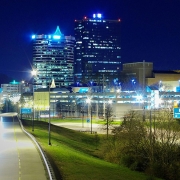Could COVID Exodus Speed the Heartland Revival?
Over the past two decades America’s largest urban areas enjoyed a heady renaissance, driven in large part by the in-migration of immigrants, minorities and young people. But even as a big-city dominated press corps continued to report on gentrification and displacement, those trends began to reverse themselves in recent years as all three of those populations started heading in ever larger numbers to suburbs, sprawling sunbelt boomtowns and smaller cities and out of the biggest ones.
That shift preceded the COVID pandemic, but has rapidly accelerated with the expansion of remote work, which has undermined the economic basis for high-end urban and post-industrial economies. Meanwhile, the severe lockdowns Democratic governors and mayors favored devastated the service and small business economies that had provided sustenance to immigrant and minority entrepreneurs and workers.
The same “canaries in the coal mine” that spurred America’s urban renaissance have been leaving its big cities in growing numbers since 2014, notes demographer Wendell Cox. New York, Los Angeles and Chicago have all begun to lose population while people have flocked to new employment hubs like Austin, Dallas, Phoenix, Columbus and Nashville that have led the way in terms of both overall new jobs and high-end business and professional service jobs.
Nowhere is this shift more evident than with immigrants. The share of the foreign born settling in big coastal “gateways” has plunged from 44 percent in 2010 to barely 35 percent in 2019. Foreign-born populations, notes Cox in research for the think tank Heartland Forward, stagnated or even declined in New York, Los Angeles and Chicago as they surged in Houston (over 25 percent growth), Dallas-Ft Worth (30 percent) Charlotte (nearly 40 percent) and Nashville (a remarkable 44 percent).
Houston, in fact, is now the most diverse major metropolitan area in the country. In 1960, Harris County, which includes Houston and many of its suburbs, was 70 percent white, non-Hispanic and 20 percent African American. Today, the county’s total population is 31 percent white and non-Hispanic, 42 percent Hispanic, 19 percent Black and 8 percent Asian. The share of foreign-born Houstonians now approaches one-fourth of the population—almost twice the average for the nation’s 50 most populous metros.
More surprising still has been the equally rapid move of immigrants to smaller cities such as Fayetteville, Ark., Knoxville, Tenn,; Cedar Rapids, Iowa, Springfield, Mo., and Fargo, N.D. The fastest growth in foreign-born populations has been in areas with traditionally low immigrant concentrations. Where the foreign-born population grew by 10 percent nationally in the last decades, in states like Georgia, Kentucky, South Carolina and the Dakotas it has expanded by 30 percent.
Racial minorities, too, are heading increasingly to the sunbelt boom towns, the south and to smaller cities. The surges in Latino, Asian and African American growth are not in Los Angeles, New York, Chicago, or the Bay Area, according to an analysis by Wendell Cox for the Urban Reform Institute, but in Atlanta, Boise, Salt Lake City, Phoenix and Las Vegas.
Again, economics is a key factor. Middle-class job creation has been generally stronger in these communities and, due to less regulation and lower taxes, costs are lower. African-American real incomes in Atlanta are more than $60,000, compared to $36,000 in San Francisco and $37,000 in Los Angeles. The median income for Latinos in Virginia Beach-Norfolk is $69,000, compared to $43,000 in Los Angeles, $47,000 in San Francisco and $40,000 in New York City. The highest Asian median household incomes are in Raleigh, Jackson, Fayetteville (AR-MO) and Austin.
Read the rest of this piece at Daily Beast.
Joel Kotkin is the author of The Coming of Neo-Feudalism: A Warning to the Global Middle Class. He is the Presidential Fellow in Urban Futures at Chapman University and Executive Director for Urban Reform Institute. Learn more at joelkotkin.com and follow him on Twitter @joelkotkin.
Photo: Brian Stansberry via Wikimedia under CC 3.0 License.









